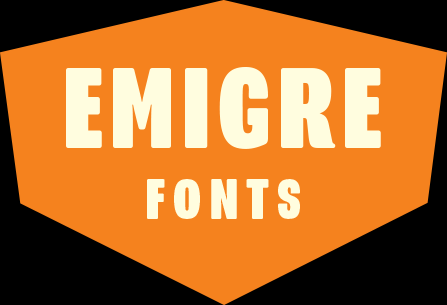Print magazine
Interview by Karli Petrovic. Published in 2016.
Karli Petrovic: What first got you interested in this topic? What made you decide to write the Emigre Fonts book?
Rudy VanderLans: I didn’t so much write it as compile it. This book binds together reprints of Emigre type specimens covering a 30-year period that started in the mid 1980s and was arguably one of the most exciting eras in typeface production since the invention of movable type. This book is a celebration of our part in that epoch. Many of these individual specimens have sold out and are no longer available, so we thought it was a valuable idea to compile them in one book.
KP: Do you have a favorite Emigre font? Any that you’re not a fan of?
RvdL: That’s a question we get asked a lot, and I probably answer it differently each time. All our fonts have unique idiosyncrasies. Some require a little more care than others to make them shine. But I’m proud of our library. There’s not a font I would remove. They’re all like snapshots. Some of the Emigre fonts are tied to the period in which they were designed, like our low-resolution fonts. Some actually came to define their era like Template Gothic (designed by Barry Deck, released in 1990), and possibly will always be associated with that time. But that’s what I love about them. That’s part of their character. Each of our fonts exudes a certain quality that is either tied to the technology of the time, the level of craftsmanship of the designer, or the prevailing esthetic preferences when they were released.
KP: What are you hoping readers take away from this book?
RvdL: This book is a record of an exciting moment in graphic design history. The Macintosh was turning the profession upside down. Digital technology, with its new set of possibilities and restrictions, required an exploratory mind set. At times we felt like Lewis & Clark’s Corps of Discovery. Our objectives were both scientific (or so we believed) and commercial, but instead of studying the land, and how to exploit it economically, we focussed on digital type. We hope the book provides readers with a taste of the excitement that we felt at that time.
Also, many of the type specimens reproduced in this book go beyond their primary function as sales tools. By creating specific contexts, the booklets were designed to be enjoyed as much for the design of the typefaces as for the often esoteric content.
KP: How do you think something like the “type specimens” would fit into design promotion today? Is it a lost art?
RvdL: I do think it is a lost art. Ever since the invention of the Internet, fewer printed type specimens are being produced as type foundries look to cut cost by using their websites and downloadable PDF files as the primary sources to exhibit and promote their typefaces. But regardless of the advancements in computer screen technology, and the effort put into hinting typefaces for better screen display, a typeface displayed on a computer screen is still only an approximation of the original, particularly at small sizes when much detail is lost. And downloading a PDF file, and then printing it on a laser printer, results in a number of unbound pages ill suited as permanent reference material.
Another benefit of printed type specimens is their materiality and how that informs us. The printing and binding techniques used, as well as the type of paper selected, are attributes that tie these objects to specific times. Their materiality is what makes them both archivable and collectible. All of that is lost when we migrate to the screen.
KP: Anything you’d like to add?
RvdL: Thanks for the opportunity.


